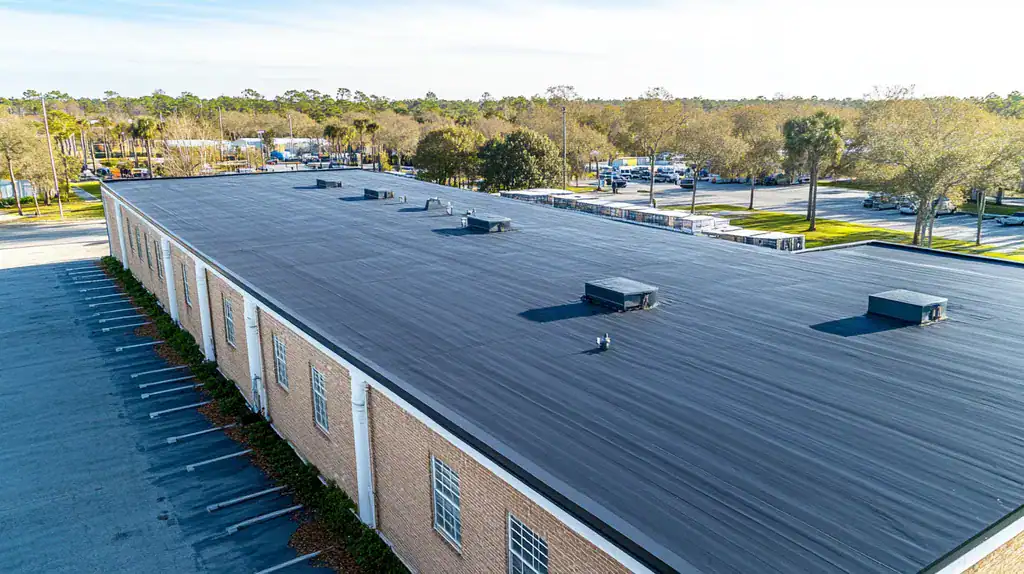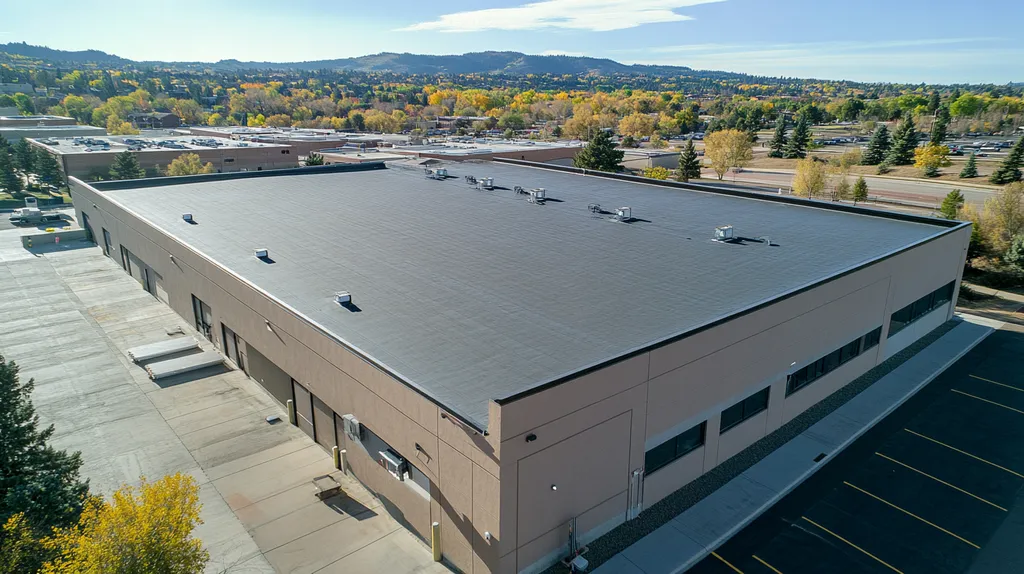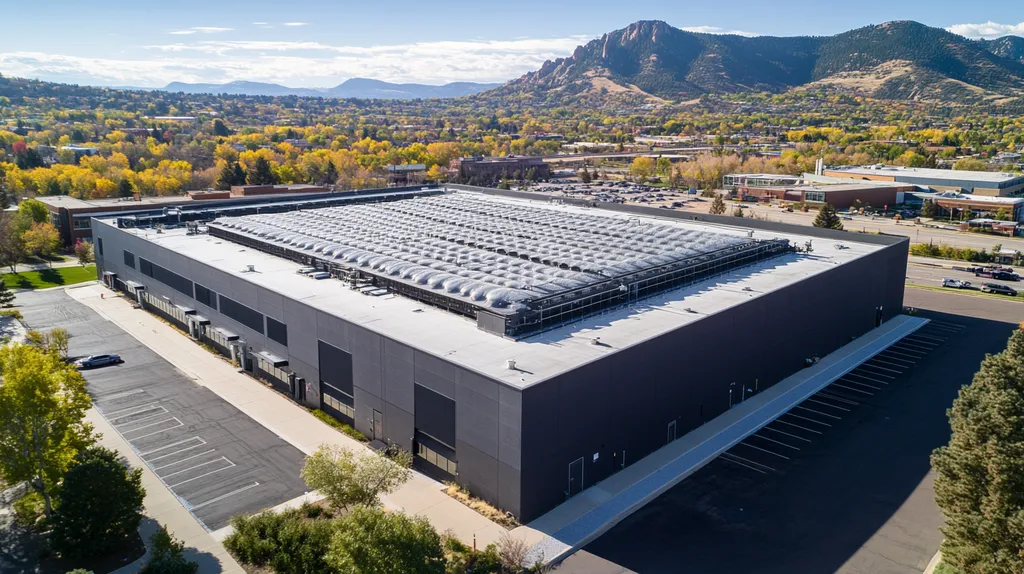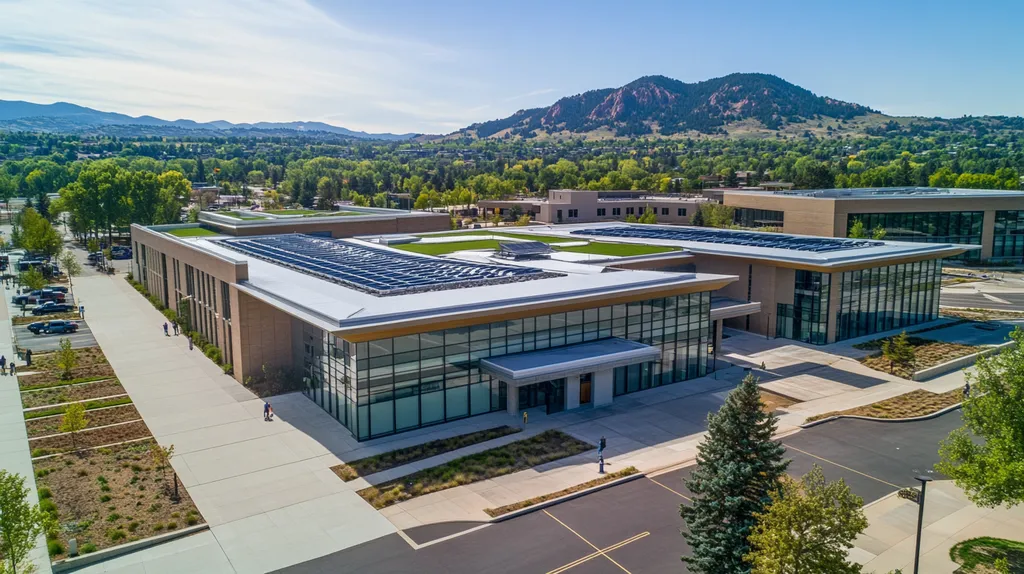Commercial roofing failures cost businesses over $2.5 billion annually, with 90% of these catastrophic events traced directly to improper application methods. For facility managers and property owners, understanding proper roof application isn’t just about maintenance – it’s about protecting millions in assets and operations.
Modern commercial roofing systems represent sophisticated engineering solutions that demand precise installation techniques and systematic maintenance approaches. From single-ply membranes to built-up systems, each technology requires specific application protocols to achieve its full performance potential.
This comprehensive guide examines the critical elements of successful commercial roof application, breaking down complex technical concepts into actionable insights for decision-makers.
SECTION 1: THE BASICS EXPLAINED
In commercial roofing, proper application methods can mean the difference between a roof that lasts decades and one that fails prematurely. Studies show that 90% of roof failures stem from poor installation practices, making application methodology the cornerstone of roof durability. The stakes are enormous – a single major leak can disrupt operations, damage inventory, and cost hundreds of thousands in repairs.
What It Is (In Plain Language)
Commercial roof application is the systematic process of installing protective layers that shield a building from environmental threats. Think of it as assembling a sophisticated shield, where each component must be precisely positioned and secured.
The process involves multiple layers working in harmony – from vapor barriers at the base to weatherproof membranes on top. Each layer serves a specific purpose, whether it’s preventing moisture infiltration or providing insulation.
Roof coating systems represent one crucial component, utilizing fluid-applied membranes that can stretch and return to their original shape. These coatings, particularly acrylic and silicone varieties, provide essential UV resistance and help extend roof life. (source: Nations Roof)
The application method chosen must account for factors like building design, local climate conditions, and specific performance requirements. Different techniques – such as mechanical fastening, heat welding, or adhesive bonding – each offer distinct advantages for particular situations.
Why It Matters (To Your Building)
Proper application directly impacts a building’s operational efficiency and maintenance costs. A correctly installed roof can last 20-30 years, while poor application can lead to failure within 5 years.
Energy efficiency hinges on proper application. Correctly installed insulation and reflective coatings can reduce cooling costs by up to 30% in summer months.
Building protection extends beyond the roof itself. Proper application prevents moisture infiltration that could otherwise compromise structural integrity, damage expensive equipment, or create harmful mold conditions.
The financial implications are significant. While proper application might cost more initially, it prevents expensive repairs and extends the roof’s service life, offering substantial return on investment.
How It Works
The application process begins with thorough surface preparation, including cleaning, repairs, and primer application where needed. This foundation step determines how well subsequent layers will adhere.
Next comes precise material placement, whether it’s rolling out membrane sheets, spraying foam insulation, or applying protective coatings. Each step requires specific temperature conditions and cure times.
Seam treatment represents a critical phase, as these junction points are potential weak spots. Proper overlap, welding, or adhesive application creates watertight bonds that prevent leaks.
Quality control occurs throughout the process, including adhesion tests, seam probing, and final inspection. This systematic verification ensures every component meets performance specifications.
The final phase includes detail work around roof penetrations, edges, and drainage systems. These areas require extra attention as they’re common points of failure when not properly addressed.
SECTION 2: PRACTICAL APPLICATIONS
Every year, thousands of commercial buildings face premature roof failures due to improper application methods, resulting in millions of dollars in damage. When a 200,000-square-foot distribution center experiences a roof failure, the consequences extend far beyond repair costs – inventory damage, operational disruptions, and insurance complications can cripple a business. Understanding practical applications of roofing systems isn’t just about maintenance – it’s about protecting your entire operation.
Common Uses & Examples
Low-slope commercial roofs demand specific application approaches based on building use and environmental conditions. Large retail spaces often benefit from thermoplastic polyolefin (TPO) membranes, which provide excellent reflectivity and weather resistance when properly heat-welded.
Manufacturing facilities with heavy equipment vibration require robust built-up roofing (BUR) systems. The multiple layers of alternating bitumen and reinforcing fabrics create a durable shield that absorbs building movement.
Cold storage facilities need specialized vapor barriers and insulation applications to prevent condensation. Precise application of these components prevents ice formation and maintains energy efficiency.
Healthcare facilities often utilize PVC membranes with hot-air welded seams. This application method creates a monolithic surface that resists chemical exposure and provides superior infection control properties.
When You Need It Most
Critical timing for proper application occurs during new construction and major renovations. These opportunities allow for comprehensive system installation without the constraints of working around existing conditions.
Extreme weather events demand immediate attention to application quality. Roofs in hurricane-prone regions require enhanced attachment methods and additional membrane securing at perimeters and corners.
Seasonal transitions present ideal windows for preventive applications. Fall preparations should focus on drainage paths and membrane integrity before winter stresses begin.
Industrial process changes often necessitate roofing modifications. New exhaust systems or equipment installations require careful application of flashings and penetration seals to maintain system integrity.
Interactions With Other Systems
Roofing systems must work in concert with building automation and energy management systems. Proper application of reflective coatings and insulation directly impacts HVAC performance and energy consumption.
Lightning protection systems require specialized application techniques. Attachment points must maintain watertight integrity while providing proper grounding pathways.
Solar panel installations demand precise application of mounting systems. Careful attention to waterproofing details prevents leaks while supporting renewable energy goals.
Drainage systems require integrated application approaches. Proper slope creation and drain flashing techniques ensure effective water management throughout the roof’s service life.
SECTION 3: KEY TERMINOLOGY DECODED
In the complex world of commercial roofing, misunderstanding key terms can lead to catastrophic consequences. When a major retail chain recently lost $2.3 million in inventory due to a roof failure, investigators traced the root cause to confusion over membrane specifications. Every year, facility managers make costly decisions based on misinterpreted roofing terminology, resulting in premature system failures and expensive repairs.
Essential Terms Explained
Single-ply membranes represent the cornerstone of modern commercial roofing, offering exceptional durability and weather resistance. These systems provide superior protection while remaining lightweight enough for most structural requirements. (source: Roofing by Landmark)
R-value measurements determine how effectively your roof resists heat transfer. Higher R-values translate directly to lower energy costs, with each point increase typically reducing heating and cooling expenses by 5-7%.
Substrate integrity refers to the structural foundation supporting your roofing system. A compromised substrate can undermine even the highest-quality membrane installation, making thorough evaluation critical.
Thermal movement describes how roofing materials expand and contract with temperature changes. Understanding this concept is crucial for selecting appropriate materials and designing proper expansion joints.
Industry Jargon Translated
Penetrations represent any object passing through the roof membrane, from HVAC units to plumbing vents. Each penetration requires specific flashing techniques to maintain watertight integrity.
Positive drainage means designing slope patterns that actively direct water toward designated outlets. Even minimal standing water can compress insulation and accelerate membrane degradation.
Lap integrity describes how well membrane sections bond at their overlapping edges. These seams represent potential failure points if not properly sealed and tested.
Wind uplift resistance indicates how effectively a roof system resists being pulled away from the building by strong winds. This rating becomes increasingly critical as extreme weather events become more common.
Measurement & Units Simplified
Square footage calculations must include vertical surfaces and parapet walls. Overlooking these elements typically results in material shortages of 15-20% during installation.
Membrane thickness is measured in mils, with each mil equaling one-thousandth of an inch. Standard commercial membranes range from 45 to 80 mils, with thicker materials offering greater puncture resistance.
Slope requirements are expressed in rise-over-run ratios, such as 1/4:12, meaning the roof rises 1/4 inch for every 12 inches of horizontal distance. Minimum slopes vary by material type and local building codes.
Coverage rates for adhesives and coatings are measured in gallons per square (100 square feet). Environmental conditions can significantly impact these rates, requiring careful monitoring during application.
SECTION 4: DECISION FACTORS
When it comes to commercial roofing decisions, the stakes couldn’t be higher. A single misstep in application method selection can result in millions in damage, lost revenue, and operational disruptions. Recent industry data shows that 40% of commercial roof failures occur within the first five years due to poor application decisions. Understanding the critical factors that influence roofing performance isn’t just about maintenance – it’s about protecting your entire business investment.
Cost Considerations
Initial installation costs represent only a fraction of the total roofing investment. While material expenses might seem daunting upfront, they typically account for just 40% of the roof’s lifecycle cost.
Labor quality significantly impacts long-term performance. Skilled installers command premium rates but deliver superior results through precise application techniques and attention to detail.
Built-up roofing (BUR) systems exemplify the complexity of cost considerations. While requiring higher initial investment, these multi-layer systems can last up to 50 years when properly installed, offering exceptional durability and protection against environmental factors. (source: American Weather Star)
Maintenance expenses vary dramatically between application methods. Some systems require annual inspections and regular repairs, while others maintain performance with minimal intervention.
Performance Trade-offs
Climate considerations dramatically influence application method effectiveness. Regions with extreme temperature fluctuations demand systems that can expand and contract without compromising integrity.
Building use patterns affect material selection. Facilities with heavy rooftop equipment traffic require robust systems that resist punctures and wear, while retail spaces might prioritize reflective properties for energy efficiency.
Installation speed versus durability presents a critical trade-off. Rapid-application systems might minimize business disruption but could sacrifice long-term performance.
Chemical exposure resistance varies significantly between systems. Manufacturing facilities must consider local emissions and process exhaust when selecting application methods.
Lifespan & Durability Factors
Application thickness directly correlates with system longevity. Thicker applications generally provide better puncture resistance and weather protection, though weight limitations must be considered.
Seam quantity and quality significantly impact durability. Some application methods create monolithic surfaces with fewer potential failure points, while others rely on proper seam welding techniques.
UV resistance capabilities vary widely between systems. Southern exposures demand enhanced protection against solar degradation, affecting both material choice and application method.
Drainage patterns influence system longevity. Proper application techniques must create and maintain positive slope, preventing water accumulation that accelerates deterioration.
SECTION 5: COMMON CHALLENGES
Every year, commercial property owners lose millions due to preventable roofing failures. Industry data reveals that 40% of commercial roofs fail before reaching even half their expected lifespan, with repair costs often exceeding initial installation expenses by 300%. These failures stem from a complex web of challenges – from material degradation to installation oversights – that compound over time to compromise roof integrity.
Frequent Problems & Solutions
Built-up roofing (BUR) systems, while offering exceptional durability with their multiple protective layers, demand meticulous installation and maintenance to achieve their potential 50-year lifespan. These systems excel in durability but require vigilant monitoring for UV-related deterioration and proper coating maintenance. (source: American Weather Star)
Water infiltration remains the primary enemy of roof integrity. Poor drainage design, inadequate slope, and compromised seams create entry points that can saturate insulation and compromise structural elements within weeks.
Membrane punctures and tears from foot traffic, equipment installation, and maintenance work create vulnerable points. Installing designated walkways and implementing strict access protocols can dramatically reduce these incidents.
Thermal movement stress causes material fatigue and seam failures. Proper expansion joint placement and material selection must account for local temperature variations to prevent systematic deterioration.
Warning Signs To Watch For
Surface blistering indicates trapped moisture beneath membranes, often preceding major leaks. Early detection through infrared scanning can identify these issues before visible damage occurs.
Membrane shrinkage manifests as pulling at perimeters and around penetrations. This subtle movement stresses seams and flashings, potentially creating gaps in the roof’s protective barrier.
Discolored or stained ceiling tiles signal active leaks that may have already caused significant damage. Tracking these indicators helps pinpoint roof vulnerabilities requiring immediate attention.
Changes in energy costs often correlate with compromised insulation or air barriers. Sudden increases in heating or cooling expenses warrant thorough roof system evaluation.
Preventative Approaches
Systematic inspection protocols remain the foundation of effective roof management. Quarterly professional assessments combined with monthly visual checks create a comprehensive monitoring system.
Data-driven maintenance scheduling optimizes resource allocation and prevents minor issues from escalating. Tracking repair history and material performance helps predict potential failure points.
Staff training programs must emphasize proper access procedures and immediate reporting of potential issues. Creating a culture of roofing awareness dramatically reduces inadvertent damage.
Emergency response planning ensures swift action when problems arise. Having pre-qualified contractors and materials readily available can minimize damage from unexpected failures.
SECTION 6: NEXT STEPS & RESOURCES
The stakes in commercial roofing have never been higher. With average repair costs exceeding $250,000 for major failures, choosing the right application methods and providers is crucial. Industry data shows that properties with properly vetted and executed roofing applications experience 70% fewer catastrophic failures and achieve nearly double the expected service life compared to those that skip due diligence.
Questions To Ask Providers
Contractor qualification verification must extend beyond basic licensing. Request detailed records of similar projects, including performance data and client references spanning at least five years.
Quality control protocols deserve intense scrutiny. Providers should detail their specific inspection points, testing methods, and documentation procedures for each phase of application.
Material handling and storage practices significantly impact performance. Ask about temperature monitoring, moisture prevention, and precise application window tracking to ensure optimal installation conditions.
Emergency response capabilities often distinguish elite providers. Verify their after-hours contact procedures, typical response times, and temporary protection measures for unexpected weather events.
Industry Standards & Guidelines
Built-up roofing (BUR) systems exemplify the critical importance of following established standards. These multi-layered systems can deliver up to 50 years of service when installed according to precise specifications, offering superior durability across diverse climate conditions. (source: American Weather Star)
ASTM International standards provide crucial benchmarks for material performance. Understanding these requirements helps property owners verify that specified products truly meet their building’s demands.
Factory Mutual (FM) ratings establish essential guidelines for wind uplift resistance. These standards become particularly critical in regions prone to severe weather events.
Local building codes often exceed national standards in specific areas. Familiarity with these requirements prevents costly compliance issues during inspections.
Further Learning Simplified
Digital learning platforms now offer comprehensive roofing education modules. These resources break down complex topics into digestible segments, allowing property owners to build expertise at their own pace.
Professional organizations provide valuable networking opportunities. Regular engagement with industry groups keeps decision-makers informed about emerging technologies and application methods.
Manufacturer training programs deliver hands-on experience with specific systems. These sessions often reveal subtle application nuances that significantly impact long-term performance.
Documentation libraries maintained by industry associations offer searchable databases of best practices. These resources help property owners develop robust specifications for their unique situations.
The Bottom Line
With over $2.5 billion lost annually to commercial roofing failures, proper application methods represent the critical difference between long-term protection and catastrophic loss.
The data is clear: 90% of roof failures trace directly to installation errors, while properly applied systems can provide 30+ years of reliable service.
Modern commercial roofing demands a sophisticated understanding of material science, application techniques, and system interactions.
Success requires moving beyond simple product selection to embrace comprehensive application protocols, rigorous quality control, and systematic maintenance approaches.
As extreme weather events increase and building systems grow more complex, the stakes for proper roof application have never been higher.
FREQUENTLY ASKED QUESTIONS
Q. What are the key elements of a commercial roof application?
A. A successful application involves proper surface preparation, accurate material placement, and effective seam treatment. Each layer must be meticulously installed to ensure optimal adhesion and weather resistance. Quality control checks throughout the process help verify structural integrity and performance.
Q. How does an industrial roof differ in application techniques?
A. Industrial roofs require unique considerations, such as durability against heavy equipment movement. Application methods must account for vibration and stress, often utilizing built-up roofing systems that can absorb movement. This ensures long-lasting performance in demanding environments.
Q. What factors influence the longevity of a commercial roof?
A. Longevity is affected by material thickness, quality of application, and environmental exposure. Choosing high-quality materials upfront can lead to extended service life, whereas improper installation can trigger premature degradation. Climate considerations are also crucial for selecting suitable materials.
Q. How can I prevent common roofing challenges?
A. Preventative measures include regular inspections, strict access protocols, and proper drainage management. Establishing a culture of awareness among staff ensures everyone knows to report potential issues immediately to prevent costly damage.
Q. What questions should I ask roofing contractors?
A. Inquire about their experience with similar projects, quality control processes, and emergency response capabilities. Understanding their material handling practices can also shed light on their installation quality and reliability.
Q. What roles do industry standards play in roofing?
A. Industry standards are vital for ensuring material performance and installation quality. Compliance with guidelines helps prevent costly failures and maintains structural integrity, especially critical in extreme weather conditions.
Q. How should I choose materials for my commercial roof?
A. Selecting materials requires assessing environmental conditions, building use, and performance needs. Consider factors like UV resistance, durability against extreme temperatures, and the specific requirements of your facility to make informed decisions that enhance longevity.











